Burned Area Mapping Using Multi-Temporal Sentinel-2 Data by Applying the Relative Differenced Aerosol-Free Vegetation Index (RdAFRI)
Abstract
:1. Introduction
2. Materials and Methods
2.1. Study Site
2.2. Sentinel-2 Data Collection
2.3. Ground Observations
2.4. AFRI-Based Algorithms Development
3. Results
4. Discussion
5. Conclusions
Author Contributions
Funding
Conflicts of Interest
References
- Williamson, G.J.; Bowman, D.M.J.S.; Price, O.; Henderson, S.B.; Johnston, F.H. A transdisciplinary approach to understanding the health effects of wildfire and prescribed fire smoke regimes. Environ. Res. Lett. 2016, 11, 125009. [Google Scholar] [CrossRef]
- Wang, J.; Zhang, X. Investigation of wildfire impacts on land surface phenology from MODIS time series in the western US forests. ISPRS J. Photogramm. Remote Sens. 2020, 159, 281–295. [Google Scholar] [CrossRef]
- Wulder, M.A.; White, J.C.; Alvarez, F.; Han, T.; Rogan, J.; Hawkes, B. Characterizing boreal forest wildfire with multi-temporal Landsat and LIDAR data. Remote Sens. Environ. 2009, 113, 1540–1555. [Google Scholar] [CrossRef]
- Al-Dhief, F.T.; Sabri, N.; Fouad, S.; Latiff, N.M.A.; Albader, M.A.A. A review of forest fire surveillance technologies: Mobile ad-hoc network routing protocols perspective. J. King Saud Univ. Comput. Inf. Sci. 2019, 31, 135–146. [Google Scholar] [CrossRef]
- Molaudzi, O.D.; Adelabu, S.A. Review of the use of remote sensing for monitoring wildfire risk conditions to support fire risk assessment in protected areas. S. Afr. J. Geomat. 2019, 7, 222. [Google Scholar] [CrossRef] [Green Version]
- Szpakowski, D.M.; Jensen, J.L.R. A Review of the applications of remote sensing in fire ecology. Remote Sens. 2019, 11, 2638. [Google Scholar] [CrossRef] [Green Version]
- Joyce, K.E.; Belliss, S.; Samsonov, S.V.; McNeill, S.; Glassey, P. A review of the status of satellite remote sensing and image processing techniques for mapping natural hazards and disasters. Prog. Phys. Geogr. Earth Environ. 2009, 33, 183–207. [Google Scholar] [CrossRef] [Green Version]
- LeBlon, B. Monitoring forest fire danger with remote sensing. Nat. Hazards 2005, 35, 343–359. [Google Scholar] [CrossRef]
- Ichoku, C.; Kaufman, Y.J.; Giglio, L.; Li, Z.; Fraser, R.H.; Jin, J.-Z.; Park, W.M. Comparative analysis of daytime fire detection algorithms using AVHRR data for the 1995 fire season in Canada: Perspective for MODIS. Int. J. Remote Sens. 2003, 24, 1669–1690. [Google Scholar] [CrossRef]
- Filipponi, F. Exploitation of sentinel-2 time series to map burned areas at the national level: A Case Study on the 2017 Italy wildfires. Remote Sens. 2019, 11, 622. [Google Scholar] [CrossRef] [Green Version]
- Sobrino, J.A.; Llorens, R.; Fernández, C.; Fernández-Alonso, J.M.; Vega, J.A. Relationship between soil burn severity in forest fires measured in situ and through spectral indices of remote detection. Forests 2019, 10, 457. [Google Scholar] [CrossRef] [Green Version]
- Christopoulou, A.; Mallinis, G.; Vassilakis, E.; Farangitakis, G.; Fyllas, N.M.; Kokkoris, G.D.; Arianoutsou, M. Assessing the impact of different landscape features on post-fire forest recovery with multitemporal remote sensing data: The case of Mount Taygetos (southern Greece). Int. J. Wildland Fire 2019, 28, 521. [Google Scholar] [CrossRef] [Green Version]
- Kaufman, Y.J.; Tucker, C.J.; Fung, I. Remote sensing of biomass burning in the tropics. J. Geophys. Res. Space Phys. 1990, 95, 9927–9939. [Google Scholar] [CrossRef]
- Wang, Q.; Guo, F.; Hu, H.; Jin, S.; Su, Z. Estimation of gases emitted by forest fires based on remote sensing data. J. For. Res. 2015, 27, 369–378. [Google Scholar] [CrossRef]
- Karnieli, A.; Kaufman, Y.J.; Remer, L.; Wald, A. AFRI—aerosol free vegetation index. Remote Sens. Environ. 2001, 77, 10–21. [Google Scholar] [CrossRef]
- Vega-Garcia, C.; Chuvieco, E. Applying local measures of spatial heterogeneity to landsat-TM images for predicting wildfire occurrence in Mediterranean landscapes. Landsc. Ecol. 2006, 21, 595–605. [Google Scholar] [CrossRef]
- Movaghati, S.; Samadzadegan, F.; Azizi, A. An agent-based approach for regional forest fire detection using modis data: A preliminary study in Iran. J. Indian Soc. Remote Sens. 2012, 41, 21–33. [Google Scholar] [CrossRef]
- Yang, J.; Pan, S.; Dangal, S.; Zhang, B.; Wang, S.; Tian, H. Continental-scale quantification of post-fire vegetation greenness recovery in temperate and boreal North America. Remote Sens. Environ. 2017, 199, 277–290. [Google Scholar] [CrossRef]
- Filipponi, F.; Valentini, E.; Xuan, A.N.; Guerra, C.A.; Wolf, F.; Andrzejak, M.; Taramelli, A. Global modis fraction of green vegetation cover for monitoring abrupt and gradual vegetation changes. Remote Sens. 2018, 10, 653. [Google Scholar] [CrossRef] [Green Version]
- Fuller, D.O. Satellite remote sensing of biomass burning with optical and thermal sensors. Prog. Phys. Geogr. Earth Environ. 2000, 24, 543–561. [Google Scholar] [CrossRef]
- Amos, C.; Petropoulos, G.P.; Ferentinos, K.P.; Feredinos, K. Determining the use of Sentinel-2A MSI for wildfire burning & severity detection. Int. J. Remote Sens. 2018, 40, 905–930. [Google Scholar] [CrossRef]
- Navarro, G.; Caballero, I.; Silva, G.; Parra, P.-C.; Vázquez, Á.; Caldeira, R.M.A. Evaluation of forest fire on Madeira Island using Sentinel-2A MSI imagery. Int. J. Appl. Earth Obs. Geoinf. 2017, 58, 97–106. [Google Scholar] [CrossRef] [Green Version]
- García-Llamas, P.; Suárez-Seoane, S.; Fernández-Guisuraga, J.M.; Fernández-García, V.; Fernández-Manso, A.; Quintano, C.; Taboada, A.; Marcos, E.; Calvo, L. Evaluation and comparison of Landsat 8, Sentinel-2 and Deimos-1 remote sensing indices for assessing burn severity in Mediterranean fire-prone ecosystems. Int. J. Appl. Earth Obs. Geoinf. 2019, 80, 137–144. [Google Scholar] [CrossRef]
- Veraverbeke, S.; Harris, S.; Hook, S. Evaluating spectral indices for burned area discrimination using MODIS/ASTER (MASTER) airborne simulator data. Remote Sens. Environ. 2011, 115, 2702–2709. [Google Scholar] [CrossRef]
- Van Leeuwen, W.J.D.; Casady, G.M.; Neary, D.G.; Bautista, S.; Alloza, J.A.; Carmel, Y.; Wittenberg, L.; Malkinson, D.; Orr, B.J. Monitoring post-wildfire vegetation response with remotely sensed time-series data in Spain, USA and Israel. Int. J. Wildland Fire 2010, 19, 75. [Google Scholar] [CrossRef]
- Key, C.; Benson, N.C. The Normalized Burn Ratio (NBR): A Landsat TM Radiometric Measure of Burn Severity. Available online: http://nrmsc.usgs.gov/research/ndbr.htm (accessed on 25 August 2020).
- Miller, J.D.; Yool, S.R. Mapping forest post-fire canopy consumption in several overstory types using multi-temporal Landsat TM and ETM data. Remote Sens. Environ. 2002, 82, 481–496. [Google Scholar] [CrossRef]
- Escuin, S.; Navarro, R.; Fernandez, P. Fire severity assessment by using NBR (Normalized Burn Ratio) and NDVI (Normalized Difference Vegetation Index) derived from LANDSAT TM/ETM images. Int. J. Remote Sens. 2007, 29, 1053–1073. [Google Scholar] [CrossRef]
- Miller, J.D.; Thode, A.E. Quantifying burn severity in a heterogeneous landscape with a relative version of the delta Normalized Burn Ratio (dNBR). Remote Sens. Environ. 2007, 109, 66–80. [Google Scholar] [CrossRef]
- Parks, S.A.; Dillon, G.K.; Miller, C. A new metric for quantifying burn severity: The relativized burn ratio. Remote Sens. 2014, 6, 1827–1844. [Google Scholar] [CrossRef] [Green Version]
- Furniss, T.J.; Kane, V.R.; Larson, A.J.; Lutz, J.A. Detecting tree mortality with Landsat-derived spectral indices: Improving ecological accuracy by examining uncertainty. Remote Sens. Environ. 2020, 237, 237. [Google Scholar] [CrossRef]
- Meddens, A.J.; Kolden, C.A.; Lutz, J.A. Detecting unburned areas within wildfire perimeters using Landsat and ancillary data across the northwestern United States. Remote Sens. Environ. 2016, 186, 275–285. [Google Scholar] [CrossRef]
- Hislop, S.; Haywood, A.; Jones, S.; Soto-Berelov, M.; Skidmore, A.; Nguyen, T.H. A satellite data driven approach to monitoring and reporting fire disturbance and recovery across boreal and temperate forests. Int. J. Appl. Earth Obs. Geoinf. 2020, 87, 102034. [Google Scholar] [CrossRef]
- Manzo-Delgado, L.L.; López-García, J. Spatial and temporal analyses of burned areas 1998, 2003 and 2015 in Montes Azules biosphere reserve, Chiapas, Mexico. Bosque 2020, 41, 11–24. [Google Scholar] [CrossRef]
- Hudak, A.T.; Morgan, P.; Bobbitt, M.J.; Smith, A.M.S.; Lewis, S.A.; Lentile, L.B.; Robichaud, P.R.; Clark, J.T.; McKinley, R.A. The relationship of multispectral satellite imagery to immediate fire effects. Fire Ecol. 2007, 3, 64–90. [Google Scholar] [CrossRef]
- Jia, J.; Wang, Y.; Zhuang, X.; Yao, Y.; Wang, S.; Zhao, D.; Shu, R.; Wang, J. High spatial resolution shortwave infrared imaging technology based on time delay and digital accumulation method. Infrared Phys. Technol. 2017, 81, 305–312. [Google Scholar] [CrossRef]
- Kaufman, Y.; Remer, L. Detection of forests using mid-IR reflectance: An application for aerosol studies. IEEE Trans. Geosci. Remote Sens. 1994, 32, 672–683. [Google Scholar] [CrossRef]
- Ben-Zeev, E.; Karnieli, A.; Agam, N.; Kaufman, Y.; Holben, B. Assessing vegetation condition in the presence of biomass burning smoke by applying the Aerosol-free Vegetation Index (AFRI) on MODIS images. Int. J. Remote Sens. 2006, 27, 3203–3221. [Google Scholar] [CrossRef]
- Hirschberger, P. Forests Ablaze: Causes and Effects of Global Forest Fires; WWF: Vaud, Switzerland, 2016; p. 108. [Google Scholar]
- Le Page, Y.; Oom, D.; Silva, J.; Jönsson, P.; Pereira, J.M.C. Seasonality of vegetation fires as modified by human action: Observing the deviation from eco-climatic fire regimes. Glob. Ecol. Biogeogr. 2010, 19, 575–588. [Google Scholar] [CrossRef]
- Short, K.C. Spatial Wildfire Occurrence Data for the United States, 1992–2015, 4th ed.; Rocky Mountain Research Station: Fort Collins, CO, USA, 2017. [Google Scholar]
- Balch, J.K.; Bradley, B.A.; Abatzoglou, J.; Nagy, R.C.; Fusco, E.J.; Mahood, A.L. Human-started wildfires expand the fire niche across the United States. Proc. Natl. Acad. Sci. USA 2017, 114, 2946–2951. [Google Scholar] [CrossRef] [Green Version]
- Baird, R.A. Pyro-terrorism—The threat of arson-induced forest fires as a future terrorist weapon of mass destruction. Stud. Confl. Terror. 2006, 29, 415–428. [Google Scholar] [CrossRef]
- Copernicus Open Access Hub. Available online: https://scihub.copernicus.eu/ (accessed on 25 August 2020).
- Gatti, A.; Naud, C.; Castellani, C.; Carriero, F. Sentinel-2 Products Specification Document; Thales Alenia Space: Cannes, France, 2018. [Google Scholar]
- Otsu, N. A threshold selection method from gray-level histograms. IEEE Trans. Syst. Man Cybern. 1979, 9, 62–66. [Google Scholar] [CrossRef] [Green Version]
- Graham, R.T.; McCaffrey, S.; Jain, T.B. Science Basis for Changing Forest Structure to Modify Wildfire Behavior and Severity USDA Forest Service, Rocky Mountain Research Station, General Technical Report RMRS-GTR-120. Available online: https://digitalcommons.usu.edu/cgi/viewcontent.cgi?article=1161&context=barkbeetles (accessed on 25 August 2020).
- Palmero-Iniesta, M.; Domènech, R.; Molina-Terrén, D.; Espelta, J.M. Fire behavior in Pinus halepensis thickets: Effects of thinning and woody debris decomposition in two rainfall scenarios. For. Ecol. Manag. 2017, 404, 230–240. [Google Scholar] [CrossRef]
- Ne’Eman, G.; Goubitz, S.; Nathan, R. Reproductive traits of Pinus halepensis in the light of fire—a critical review. Plant Ecol. 2004, 171, 69–79. [Google Scholar] [CrossRef]
- Ting, K.M. Confusion Matrix. In Encyclopedia of Machine Learning and Data Mining; Springer Science and Business Media LLC: Berlin/Heidelberg, Germany, 2017; p. 260. [Google Scholar]
- Doerr, S.H.; Santin, C. Global trends in wildfire and its impacts: Perceptions versus realities in a changing world. Philos. Trans. R. Soc. B Boil. Sci. 2016, 371, 20150345. [Google Scholar] [CrossRef]
- Cochrane, M.A. Burning questions about ecosystems. Nat. Geosci. 2019, 12, 86–87. [Google Scholar] [CrossRef]
- Veraverbeke, S.; Hook, S.; Harris, S. Synergy of VSWIR (0.4–2.5 μm) and MTIR (3.5–12.5 μm) data for post-fire assessments. Remote Sens. Environ. 2012, 124, 771–779. [Google Scholar] [CrossRef]


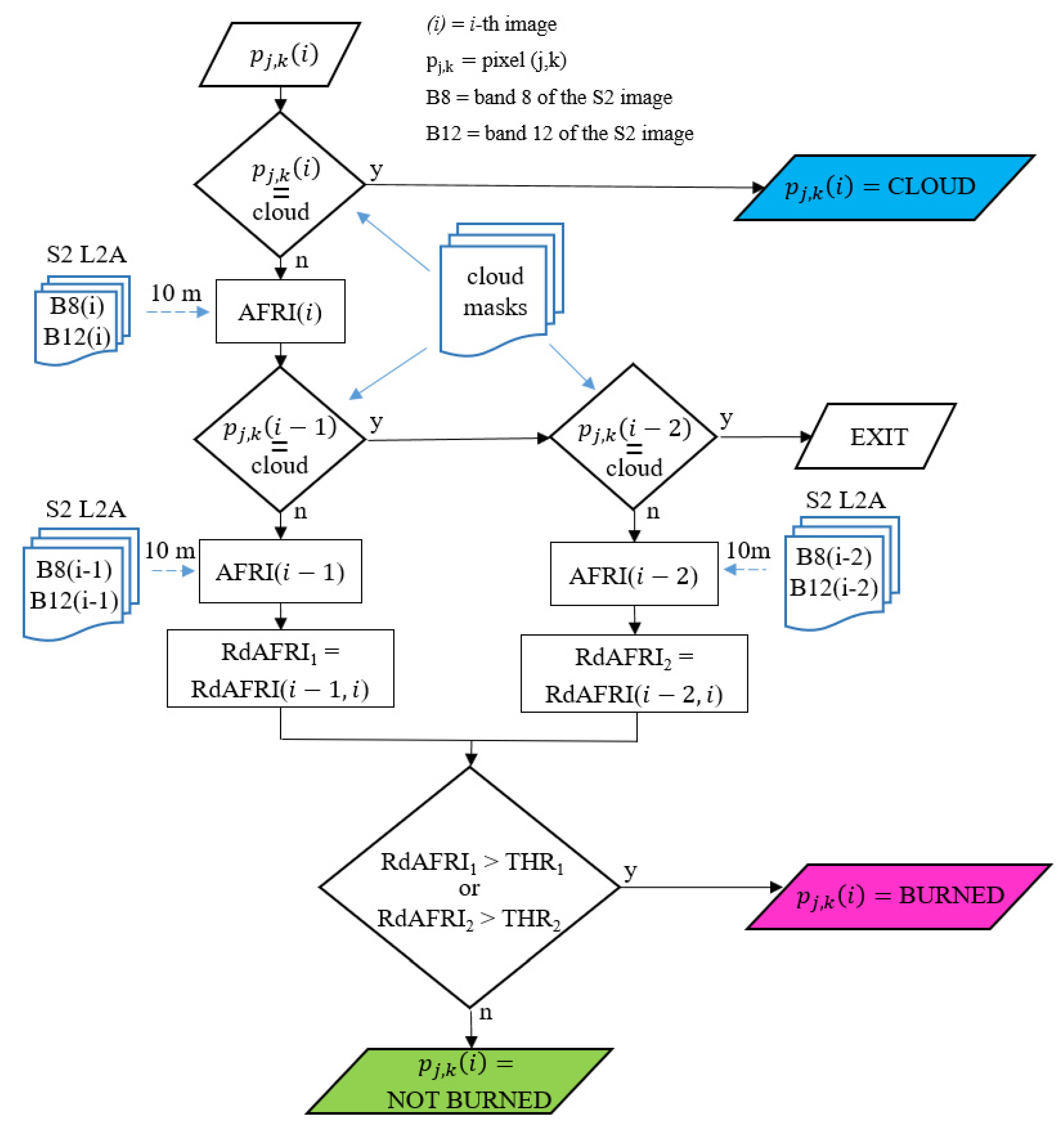

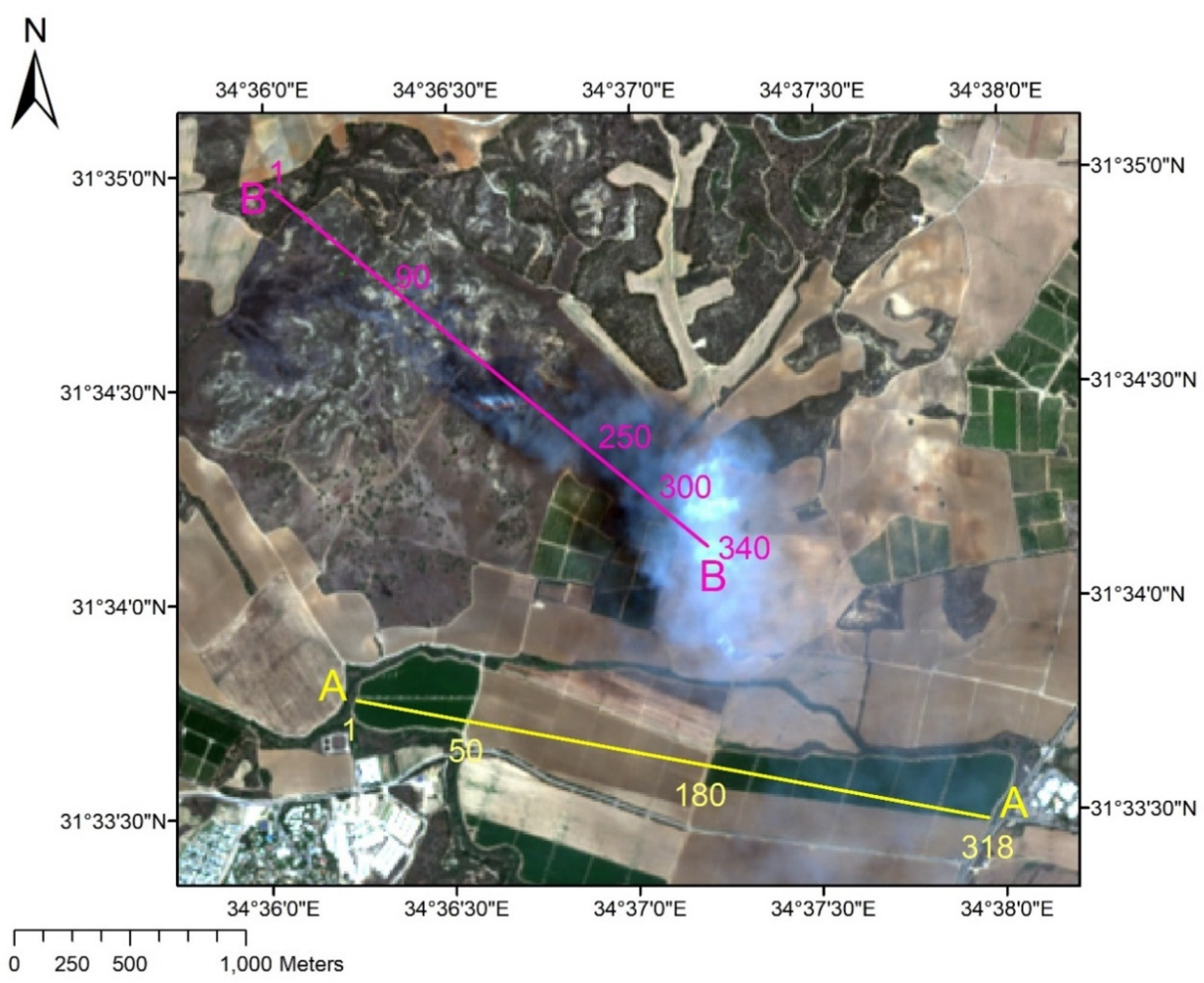
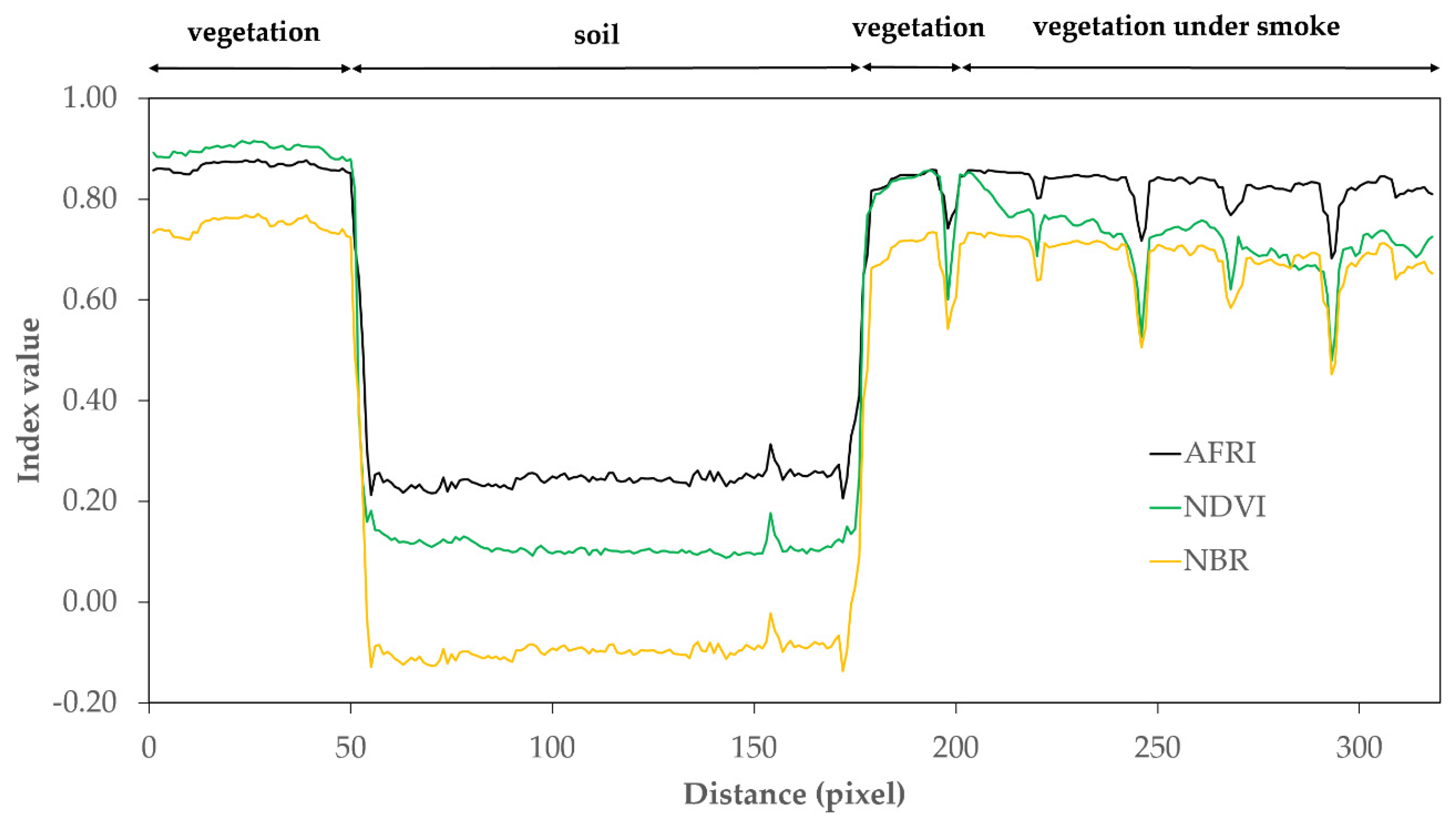
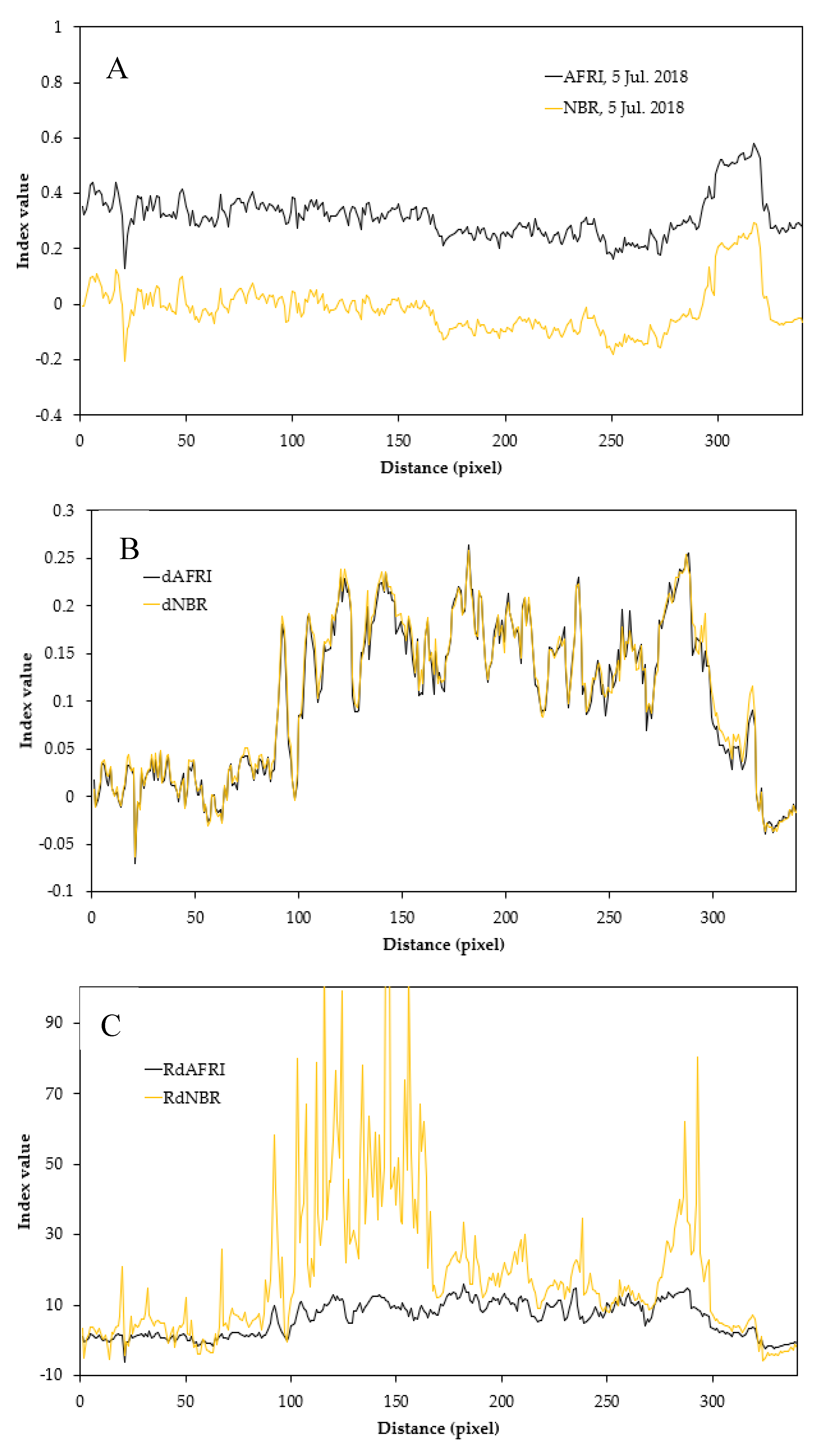
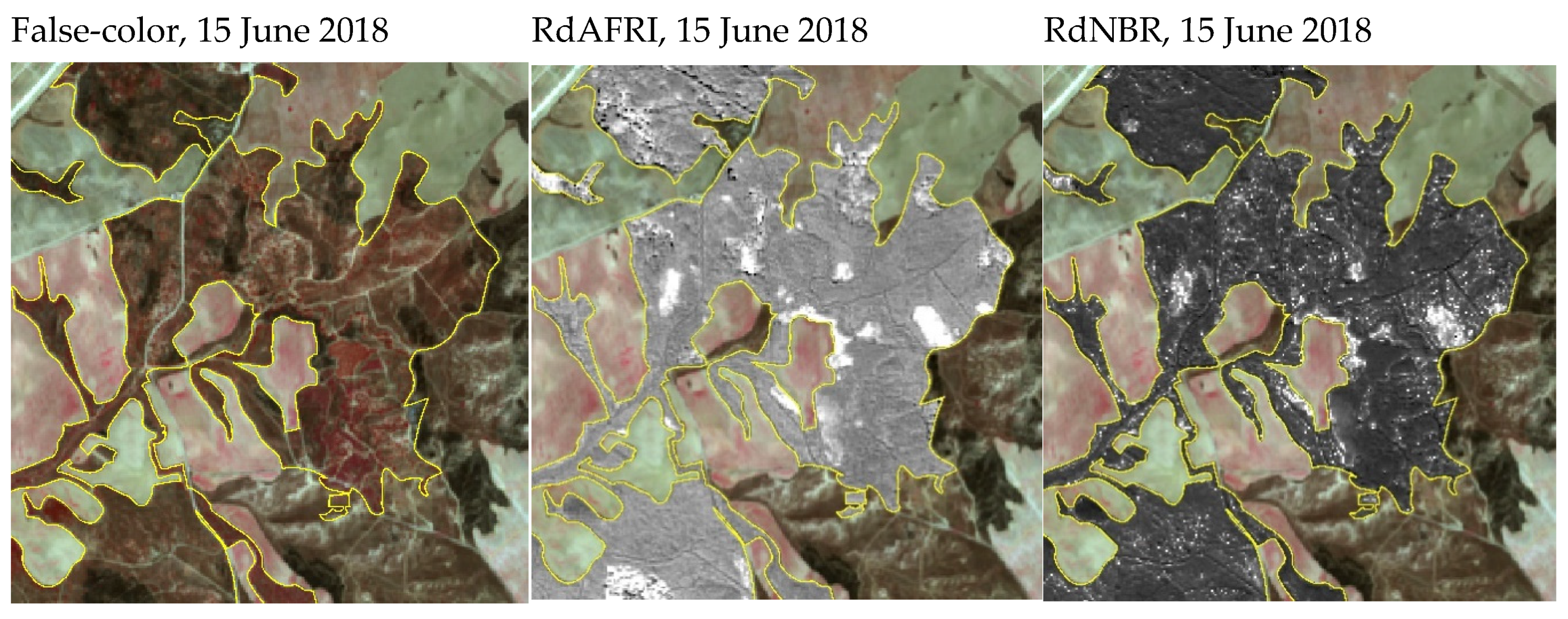
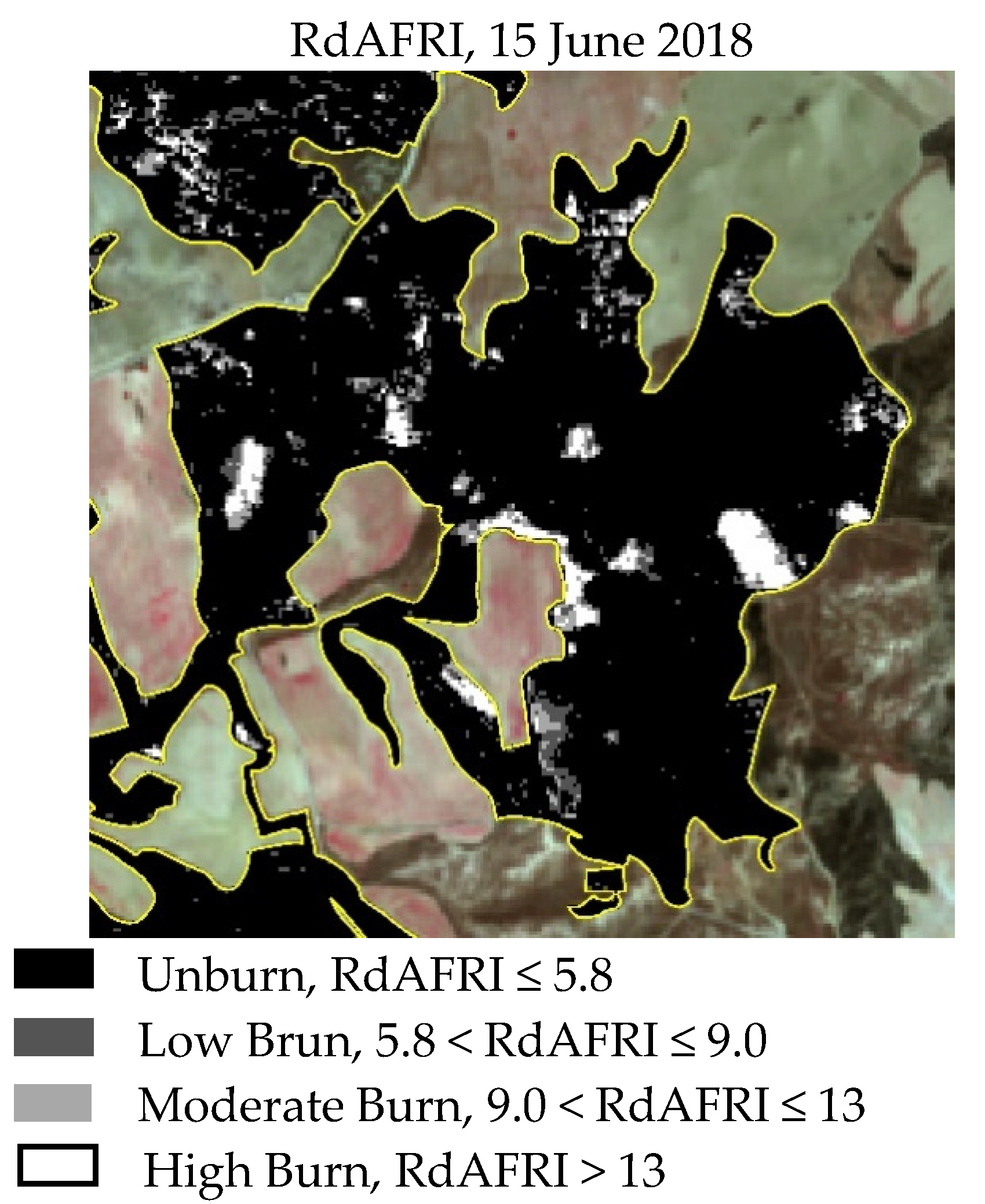


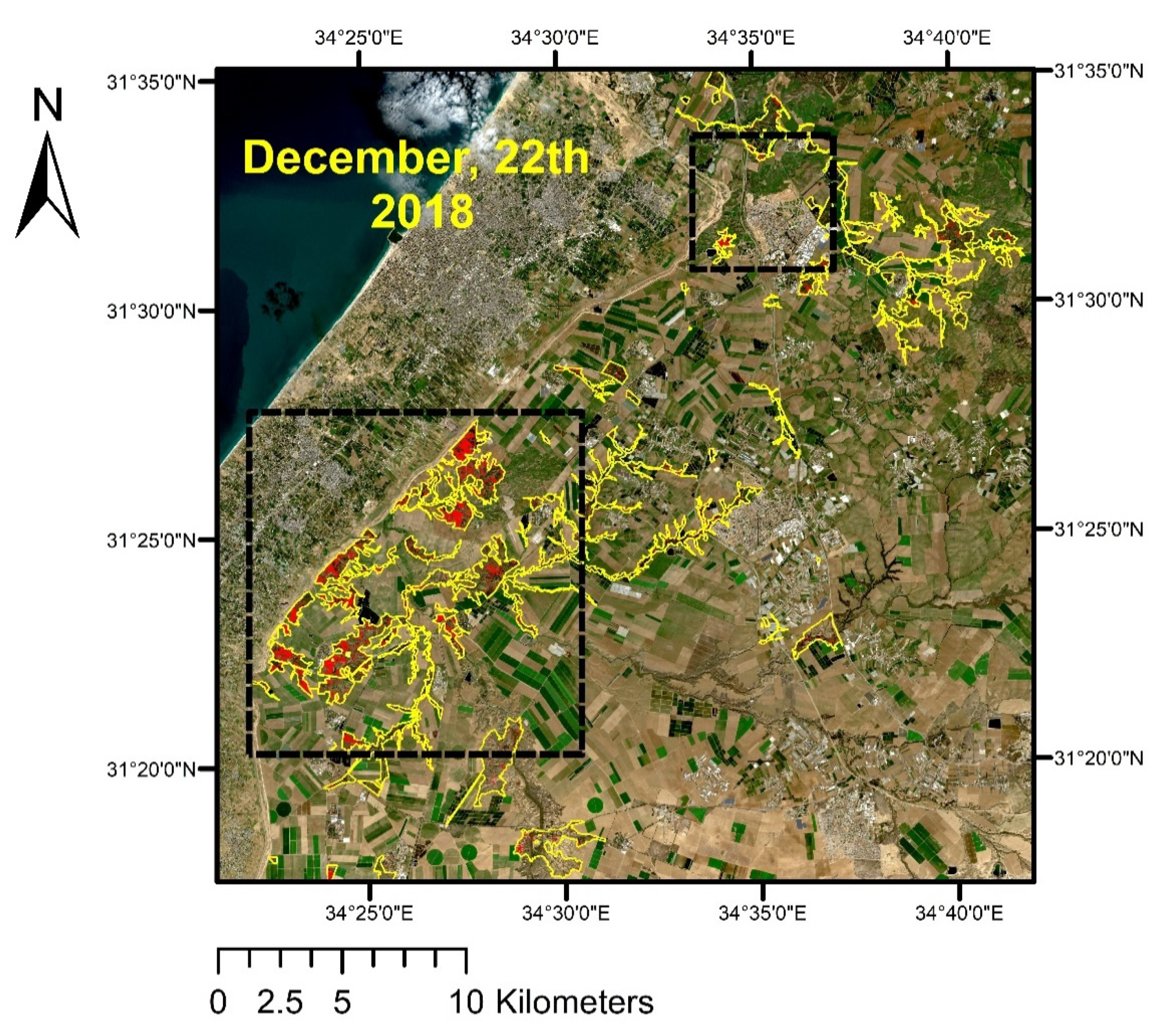
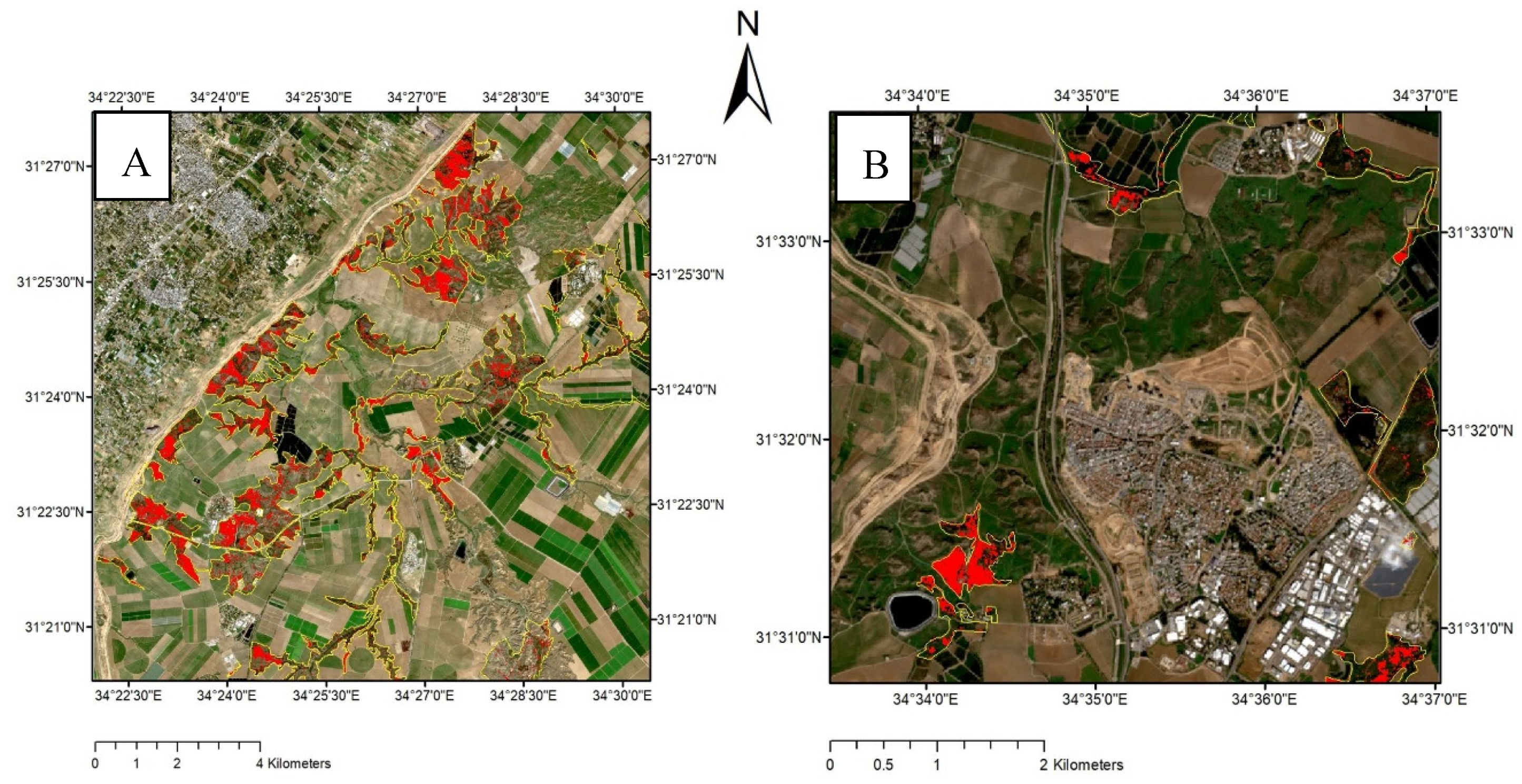

| Type of Plants | Surface (km2) |
|---|---|
| Eucalyptus | 21.02 |
| Planted—coniferous | 5.84 |
| Planted—mixed coniferous and broadleaf | 5.75 |
| Planted–broadleave, Israeli species | 5.00 |
| Planted—broadleave, introduced species | 6.89 |
| Planted—other | 0.43 |
| Open landscape, bare soil | 2.32 |
| Planted—sparse | 2.54 |
| Orchard, bustan | 0.07 |
| Planted—shrubs | 0.03 |
| Desert shrubland | 0.7 |
| Garigue | 0.60 |
| Woodland | 0.05 |
| Total | 51.24 |
| Image Date | NI RdAFRI | NI RdNBR |
|---|---|---|
| 16 April 2018 | 0.022 | 4.317 |
| 11 May 2018 | 0.139 | 57.383 |
| 21 May 2018 | 0.055 | 15.943 |
| 5 June 2018 | 0.234 | 40.221 |
| 15 June 2018 | 0.088 | 51.396 |
| 25 June 2018 | 0.085 | 13.692 |
| 5 July 2018 | 0.087 | 9.678 |
| 10 July 2018 | 0.098 | 31.082 |
| 25 July 2018 | 0.294 | 16.423 |
| Image i | Image Date in 2018 | Clouds (%) | Burned Area (km2) | Additional Burned Area (km2) | Accumulated Burned Area (km2) | Ratio (%) | THR1 | THR2 |
|---|---|---|---|---|---|---|---|---|
| 1 | 6 April | 0.00 | - | - | - | - | - | - |
| 2 | 16 April | 0.08 | 0.01 | 0.00 | 0.01 | 0.01 | 12 | - |
| 3 | 11 May | 1.82 | 0.28 | 0.28 | 0.28 | 0.56 | 12 | 12 |
| 4 | 21 May | 0.11 | 0.87 | 0.86 | 1.14 | 2.24 | 5.8 | 12 |
| 5 | 5 June | 3.32 | 1.28 | 1.18 | 2.32 | 4.56 | 5.8 | 12 |
| 6 | 15 June | 0.08 | 2.32 | 1.86 | 4.18 | 8.23 | 5.8 | 12 |
| 7 | 25 June | 0.12 | 1.93 | 1.79 | 5.97 | 11.74 | 5.8 | 12 |
| 8 | 5 July | 0.33 | 0.60 | 0.42 | 6.39 | 12.55 | 5.8 | 12 |
| 9 | 10 July | 0.12 | 0.38 | 0.15 | 6.54 | 12.85 | 12 | 12 |
| 10 | 25 July | 0.17 | 0.27 | 0.24 | 6.78 | 13.33 | 5.8 | 12 |
| 11 | 24 August | 0.20 | 0.34 | 0.11 | 6.89 | 13.54 | 12 | 12 |
| 12 | 29 August | 14.08 | 0.00 | 0.00 | 6.89 | 13.54 | 35 | 35 |
| 13 | 3 September | 0.66 | 0.00 | 0.00 | 6.89 | 13.54 | 35 | 35 |
| 14 | 13 September | 11.53 | 0.00 | 0.00 | 6.89 | 13.55 | 12 | 12 |
| 15 | 18 September | 0.93 | 0.03 | 0.00 | 6.89 | 13.55 | 35 | 35 |
| 16 | 23 September | 5.13 | 0.11 | 0.04 | 6.94 | 13.63 | 12 | 12 |
| 17 | 28 September | 0.51 | 0.01 | 0.00 | 6.94 | 13.64 | 35 | 35 |
| 18 | 3 October | 8.93 | 0.00 | 0.00 | 6.94 | 13.64 | 35 | 35 |
| 19 | 28 Oct0ber | 0.26 | 0.01 | 0.00 | 6.94 | 13.64 | 35 | 35 |
| 20 | 2 November | 0.25 | 0.07 | 0.03 | 6.96 | 13.69 | 12 | 12 |
| 21 | 12 November | 7.92 | 0.01 | 0.01 | 6.97 | 13.70 | 35 | 35 |
| 22 | 17 November | 4.09 | 0.00 | 0.00 | 6.97 | 13.70 | 35 | 35 |
| 23 | 12 December | 1.59 | 0.01 | 0.01 | 6.98 | 13.72 | 12 | 12 |
| 24 | 17 December | 4.03 | 0.03 | 0.03 | 7.01 | 13.78 | 12 | 12 |
| 25 | 22 December | 4.21 | 0.01 | 0.01 | 7.02 | 13.79 | 12 | 12 |
| Algorithm Classification | |||||
|---|---|---|---|---|---|
| Ground-Truth Data | Burned Area | Not Burned Area | Total | Accuracy | |
| Burned area | 563 | 313 | 876 | 64% | |
| Not burned area | 187 | 3875 | 4062 | 95% | |
| Total | 750 | 4188 | - | - | |
| Overall accuracy | 75% | 93% | - | 90% | |
| Type of Vegetation | Burned Area (km2) | Burned Area (%) |
|---|---|---|
| Eucalyptus | 3.44 | 16.36 |
| Planted—coniferous | 0.85 | 14.64 |
| Planted—mixed coniferous and broadleaf | 0.52 | 8.99 |
| Planted—broadleaf, Israeli species | 0.44 | 8.79 |
| Planted—broadleaf, introduced species | 0.74 | 10.71 |
| Planted—other | 0.01 | 3.07 |
| Open landscape, bare soil | 0.21 | 9.06 |
| Planted—sparse | 0.43 | 17.12 |
| Orchard, bustan | 0.00 | 0.85 |
| Planted—shrubs | 0.00 | 14.78 |
| Desert shrubland | 0.13 | 18.99 |
| Garigue | 0.18 | 30.40 |
| Woodland | 0.00 | 0.00 |
| Algorithm Classification | |||||
|---|---|---|---|---|---|
| Ground-Truth Data | Burned Area | Not Burned Area | Total | Accuracy | |
| Burned area | 309 | 151 | 460 | 67% | |
| Not burned area | 49 | 980 | 1029 | 95% | |
| Total | 358 | 1131 | - | - | |
| Overall accuracy | 86% | 87% | - | 87% | |
| Algorithm Classification | |||||
|---|---|---|---|---|---|
| Ground-Truth Data | Burned Area | Not Burned Area | Total | Accuracy | |
| Burned area | 300 | 160 | 460 | 65% | |
| Not burned area | 132 | 897 | 1029 | 87% | |
| Total | 432 | 1057 | - | - | |
| Overall accuracy | 69% | 84% | - | 80% | |
| Algorithm Classification | |||||
|---|---|---|---|---|---|
| Ground-Truth Data | Burned Area | Not Burned Area | Total | Accuracy | |
| Burned area | 310 | 152 | 462 | 67% | |
| Not burned area | 85 | 942 | 1027 | 92% | |
| Total | 395 | 1094 | - | - | |
| Overall accuracy | 78% | 86% | - | 84% | |
© 2020 by the authors. Licensee MDPI, Basel, Switzerland. This article is an open access article distributed under the terms and conditions of the Creative Commons Attribution (CC BY) license (http://creativecommons.org/licenses/by/4.0/).
Share and Cite
Salvoldi, M.; Siaki, G.; Sprintsin, M.; Karnieli, A. Burned Area Mapping Using Multi-Temporal Sentinel-2 Data by Applying the Relative Differenced Aerosol-Free Vegetation Index (RdAFRI). Remote Sens. 2020, 12, 2753. https://doi.org/10.3390/rs12172753
Salvoldi M, Siaki G, Sprintsin M, Karnieli A. Burned Area Mapping Using Multi-Temporal Sentinel-2 Data by Applying the Relative Differenced Aerosol-Free Vegetation Index (RdAFRI). Remote Sensing. 2020; 12(17):2753. https://doi.org/10.3390/rs12172753
Chicago/Turabian StyleSalvoldi, Manuel, Gil Siaki, Michael Sprintsin, and Arnon Karnieli. 2020. "Burned Area Mapping Using Multi-Temporal Sentinel-2 Data by Applying the Relative Differenced Aerosol-Free Vegetation Index (RdAFRI)" Remote Sensing 12, no. 17: 2753. https://doi.org/10.3390/rs12172753
APA StyleSalvoldi, M., Siaki, G., Sprintsin, M., & Karnieli, A. (2020). Burned Area Mapping Using Multi-Temporal Sentinel-2 Data by Applying the Relative Differenced Aerosol-Free Vegetation Index (RdAFRI). Remote Sensing, 12(17), 2753. https://doi.org/10.3390/rs12172753







